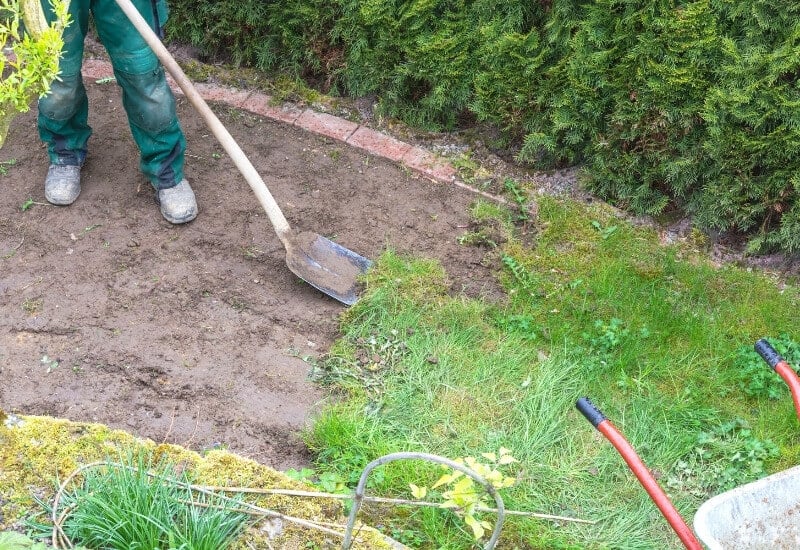
Grass is a protagonist of gardening; the English lawn fills with green home gardens and public parks alike. But grass becomes “weed” when it starts popping up in flower beds, borders and other places where you don’t want it.
So, how can you make sure that you only have grass where you need it, and not between your petunias and daisies?
There are different ways of eliminating grass from flower beds; weed killers are a common method, but they come with risks. Alternatively, there are organic methods, including innovative ones like covering the ground. If your garden is small, you may still prefer the old fashioned hand weeding method. In each case, the choice is yours and it depends on a series of factors.
There are many elements you need to consider before choosing the best method to control/remove unwanted grass in flower beds, including whether the flower bed is already planted, how large it is, and last but not least the environmental impact.
And if you need clear guidelines on how to choose the right method and how to carry out weeding successfully, all you need to do is read on.
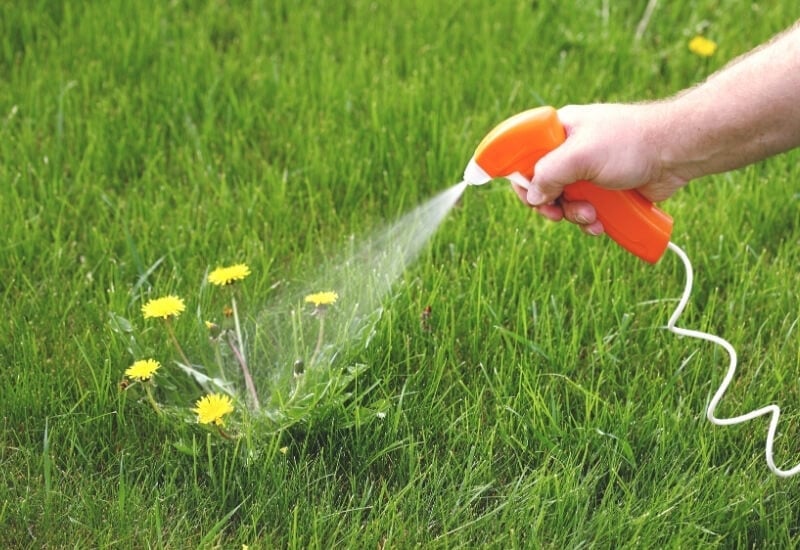
Assessing Your Weed Problem
The first thing you need to do is assess how serious your problem is in your garden, and where exactly these weeds are taking hold.
Once you have a clear picture, you will be better informed to choose the best weeding method for your garden, flower bed or border.
Here are the key factors that you will need to keep in mind.
1. Are You Trying To Prevent Grass From Growing?
If you are planning a new flower bed, or even a whole garden, this is actually the most fruitful time to think about weeds.
You can prevent them from growing very successfully and with no need for chemicals. Prevention is better than cure also when it comes to our green friends.
2. Have Weeds Cropped Up In Your Planted Flower Bed?
The situation is different if you have a flower bed with plants in it already and you start seeing weeds. Here the best thing to do is act early.
However, this also depends on the gravity of the situation, which leads us straight into the next points.
3. How Serious Is The Weed Infestation?
In the best case scenario, you will spot the problem early and you will just have a few weeds. If this is your case, very often even a quick hand weeding followed by some mulching will sort out all your problems.
However, if the weeds have settled, and especially if they have grown an extensive root system, you may have to take more drastic measures.
4. What Types Of Plants Do You Have In Your Beds?
This may sound surprising, but if you have perennials, you will not be able to use traditional weed killers; your alternative is to use selective weed killers, or alternative methods.
With annuals, on the other hand, you may decide to sacrifice a crop to settle the problem if it is serious enough. Annuals on the whole will not survive most weed killers.
5. What Is The Environmental Impact You Wish To Have?
Of course, if your garden is organic, no use of chemical weed killers is allowed. But even if you are not organically inclined, do keep in mind that every chemical product will have an effect on your plants.
Similarly, if you are growing food crops (in the bed or near the bed), do remember that these plants will absorb the toxic elements of chemical weed killers and you will end up eating them.
6. What Type Of Weed Do You Have?
Some grass is easily disposed of, while other species are tough indeed! One of the most common and popular weeds is couch grass, or Elymus repens. It affects virtually every garden in most temperate regions.
Plants like this are hard to weed because the produce overground stolons or (even worse!) creeping rhizomes. When you pull the plant, these will break and propagate the very weed you wanted to get rid of.
So… check if the weed you have has rhizomes or stolons. If it does, you will need to choose a carpet method, one that eliminates all roots in the area affected.
Now you know what to look for to make an informed decision, we can safely move to the different methods available.
6 Methods for Killing Grass in Flower Beds
There are many methods for killing grass in your garden, but these are the tried and tested ways you can try to kill grassy weeds from your in flower beds:
1. Hand weeding grass from your flower bed
2. Apply pre-emergent herbicide
3. Selective post-emergent herbicide
4. Apply a bed filled with mulch that prevents grassy weeds from growing
5. Smothering the grass
6. Try soil solarization to kill unwanted grass
But which one is best for you? We are going to find out right away!
1: Hand Weeding Grass From Flower Beds
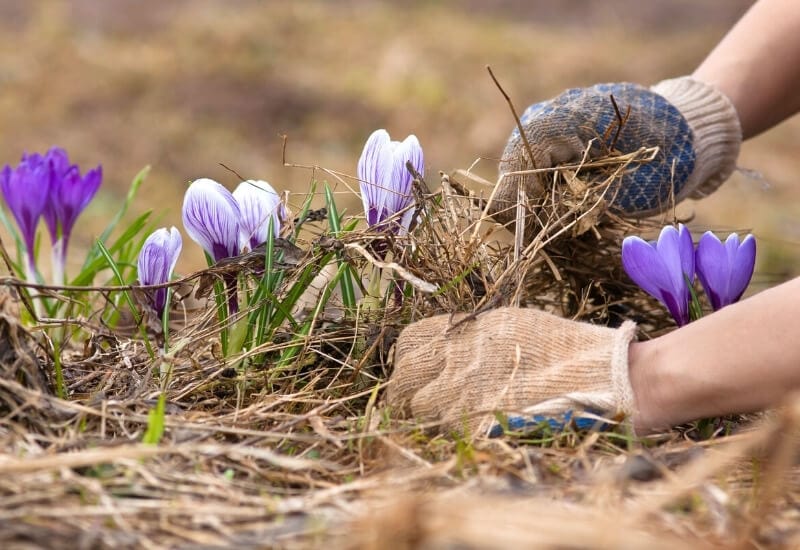
If it is just a matter of a few blades of grass (or other leaf shape) and a small area, the oldest but also gentlest method of eliminating it is hand weeding.
This was once a profession! Yes, women (especially) were paid to hand weed whole fields, and some ended up with a hunchback following years of bending over beds and rows of vegetables…
But even hand weeding has its tricks.
Do it when the soil is loose and soft.
You should never do it just after a heavy downpour. The roots will be heavy and you will end up breaking them (and the plants will grow back). Also, you will end up removing lots of soil from your beds.
With clay, however, it is hard to do it when the soil is fully dry. Do it instead a few days after it has rained, when it is still humid, but not wet (clay is heavy!) nor dry (clay compacts into a solid block!)
The easiest types of soil to hand weed is sand, followed by loam.
2. Wear gloves
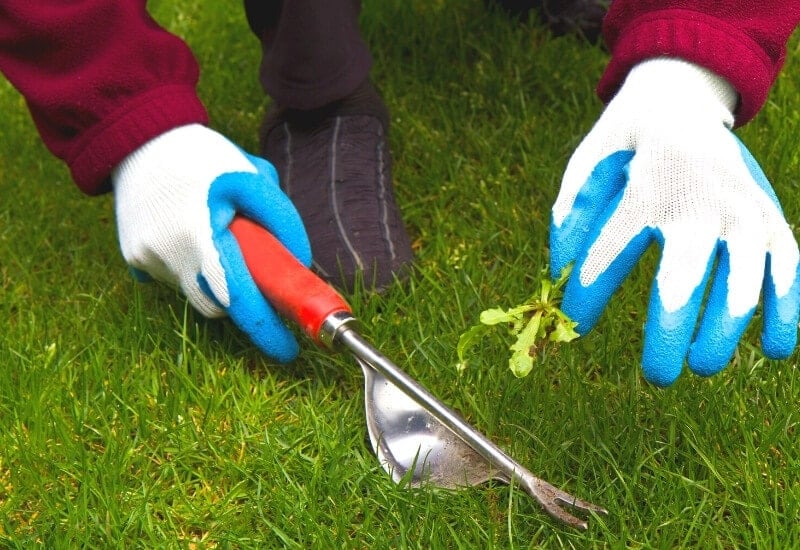
You can do it without and some people prefer it. But you may want to wear gloves if you suspect there are some irritant grass plants.
3. Pull the plant by the base
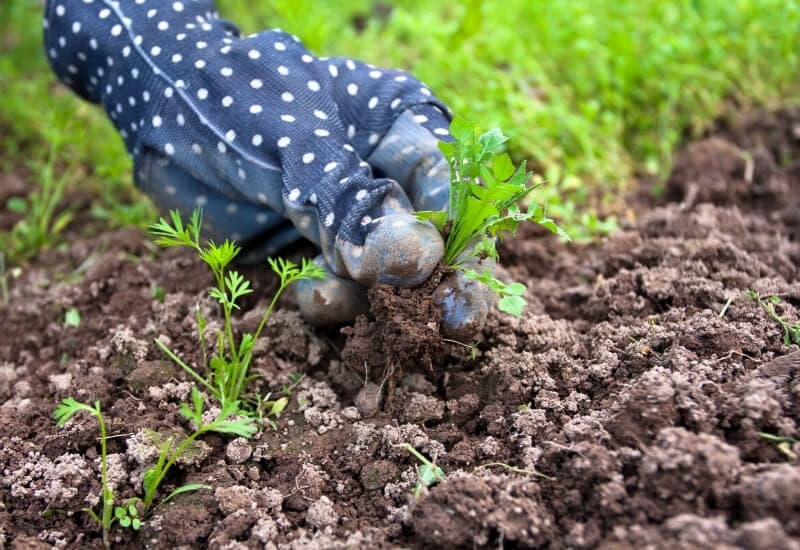
Grab the plant as close as possible to the ground and pull it. This will allow you to remove the roots.
By all means don’t do it fast; weeding needs to be slow. Otherwise, you will rip off the aerial part of the plant from the roots. Twisting the plant may help with stubborn grass.
4. Stack the plants where they Sun will dry them
Put all the grass you have weeded in a sunny spot. The Sun will dry it up. Then, remove it and put it it your compost heap.
2: Apply Pre-Emergent Herbicide
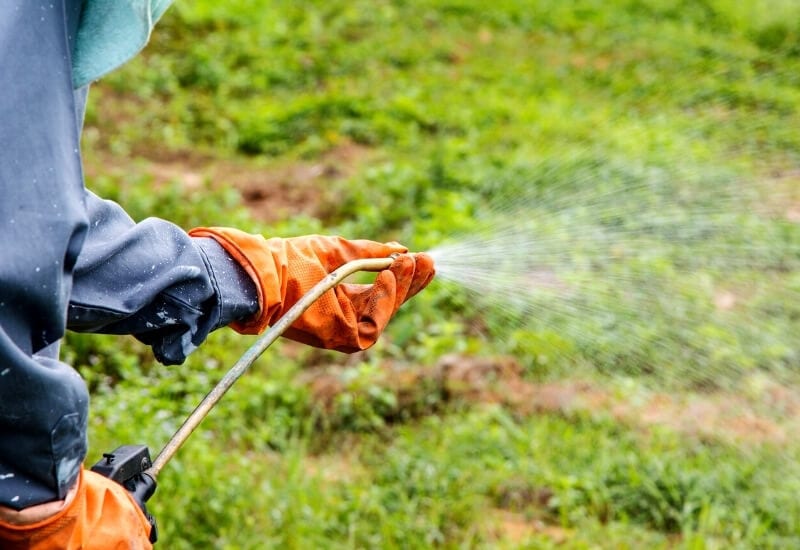
A pre-emergent herbicide will not kill any weeds, but it will stop any seeds from germinating. This is the type of herbicide you may choose if you have already planted your flower bed.
Note, however, that pre-emergent herbicides are chemical. While they will not kill most perennials, many annuals will likely die. Read on the package which plants will not survive with your specific herbicide before buying it. Most pre-emergent herbicides come in granular form.
1. Hand weed the flower bed
Clear the bed from any weed by hand.
2. Carefully read the instruction and dosage on the package
Do not be tempted to overdose; you are handling a potentially dangerous substance.
3. Scatter the granules on the soil
These herbicides need to be distributed evenly on top of the ground, so that they can diffuse homogeneously into the soil.
4. Water the flower bed
After applying the herbicide, you will need to water the flower bed to make sure that the herbicidal components dissolve into the soil. Aim to pour about ½ inch of water (1.2 cm).
5. Repeat the treatment after 60 to 90 days
You may need to repeat the treatment after 2 or 3 months, as new seeds will have dropped on the soil. Alternatively, mulch your flower bed.
3: Selective Post-Emergent Herbicide
A post-emergent herbicide will kill the grass you want out of your flower bed. However, you should not use a generic post-emergent herbicide because it will likely kill your flowers as well.
1. Choose a selective post-emergent herbicide that will not damage your plants
This is the most fundamental step; you will need to choose carefully. These herbicides will tell you which type of grass they kill on the label. This may not include all your weeds. In case, choose the most vigorous one.
2. Apply the selective post-emergent herbicide on your flower bed
Read carefully the dosage on the herbicide container.
You will need to coat the surface of the flower bed with the herbicide. In most cases, they come in spray bottles. If not, it would be ideal to pour into a spray bottle. Make sure you do not use this bottle for any other reason afterwards.
If it is granular, scatter the granules on top of the soil as indicated on the box.
3. Water the flower bed if you have used granular selective pre-emergent herbicide
Only if granular, you should aim to pour about ½ inch of water (1.2 cm) on the soil of the flower bed. If the herbicide is liquid, do not water it.
4. Re-apply your selective pre-emergent herbicide if the grass comes back
You will have to re-apply it months later when new weeds come back. If you don’t want to risk this, use alternative organic methods like mulching.
4: Natural Ways To Kill Grassy Weeds In Garden Beds
The chemical methods we have seen so far were the norm once, but they are being replaced by organic and alternative methods.
As you have seen, chemical methods are not permanent solutions and they will pollute the environment. They also weaken your plants’ immune systems.
So, let’s look at some great alternative and organic methods for weeding your flower bed from that unwanted grass.
1: Mulching
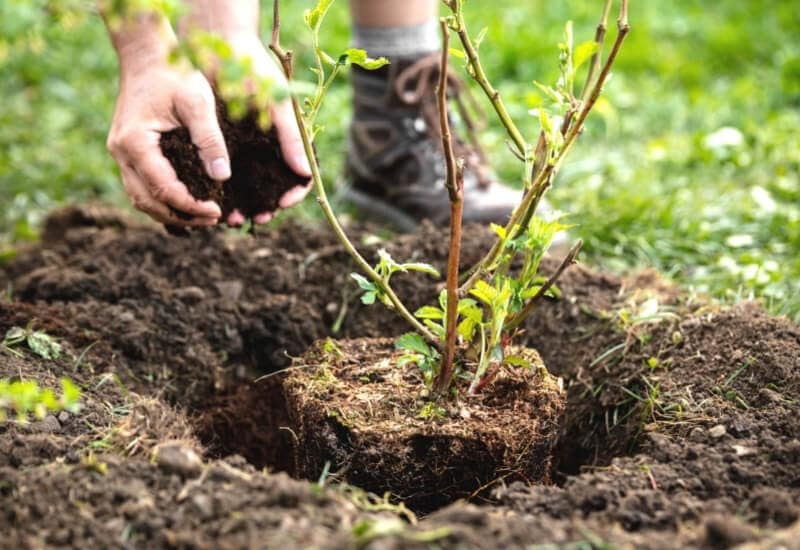
Mulch can be used both as a preventive method and after you have planted your flower beds. It is by far one of the most effective methods; it also looks good in flower beds and, finally… It can almost be permanent…
1. Choose the mulch
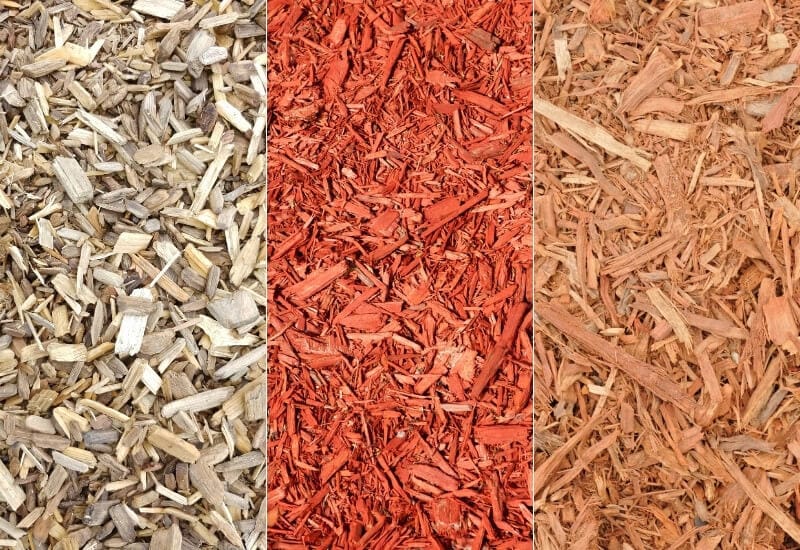
There are many types of mulch. In fact, any covering material for the ground is technically a mulch, even an old blanket or carpet… The most common are:
2. Hand weed the flower bed if necessary
This will not be necessary if you are setting up a new bed. In this case, you can just till the soil, even it out with a rake and then mulch.
3. Water the flower bed
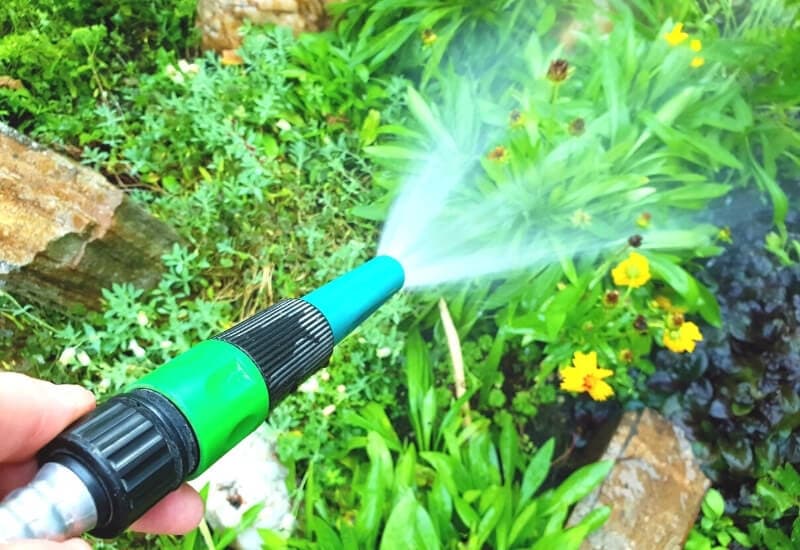
Once the weeds are out of the way, you should water the flowerbed lightly. Make it moist, not wet. When you apply the mulch, it will also retain the moisture for your flowers and you will need to water less!
4. Apply the mulch
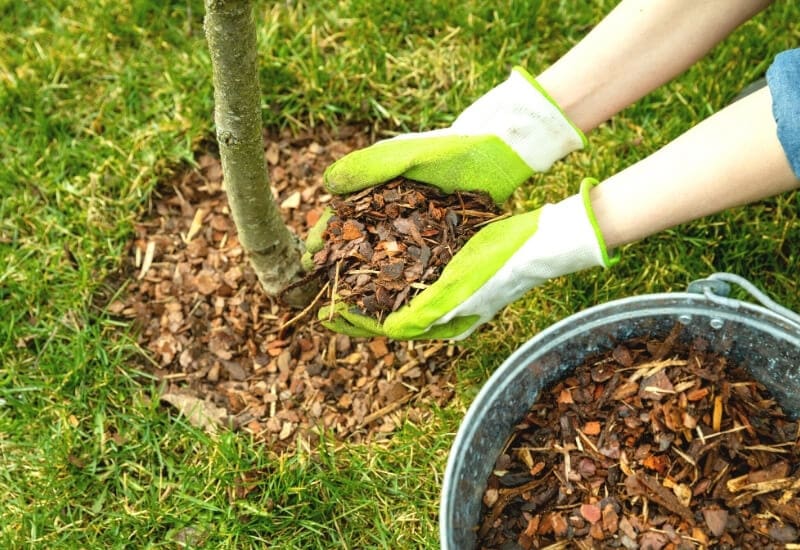
Cover the exposed soil evenly with about 3 inches of mulch (7.5 cm). That’s it! You won’t have to deal with weeds any more until the mulch is in place… With some types of wood bark, this means for years!
5. Add to the mulch if necessary
There may be a bit of maintenance later on. With leaves and straw it may be after months. With bark we are talking at least after a year… Just add to the mulch where you see that it has gotten thinner. Easy!
2: Smothering The Grass
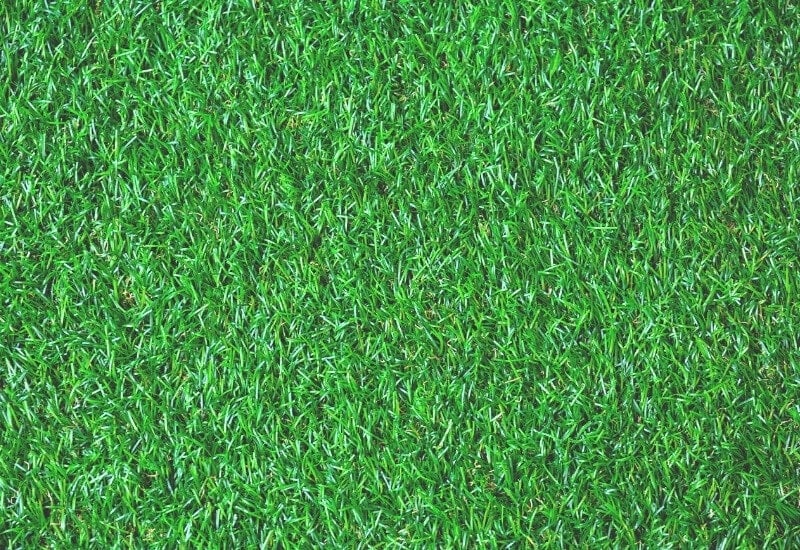
This is an excellent method for preparing flower beds and vegetable beds, and a favorite with organic gardeners. It is also cheap, safe and quite eco-friendly as it will help you recycle those unwanted newspapers in your cupboard.
The concept is to choke the grass by depriving it from light so that it will die before you plant your flowers.
All you will need are old newspapers, cardboard sheets or even old carpets and black (or dark) plastic sheets (which you will then recycle).
1. Reduce the grass
With this method, it is not necessary to remove the grass fully to start with. The sheets will do it… As long as it is short enough to be smothered, you will be fully successful. You could turn the soil with a hoe or a spade if you want to. If the grass is not thick and not well established, you could just cut it.
2. Cover the flower bed with the sheets
By sheets we mean the newspapers, cardboard sheets, carpets etc… Just make sure that they overlap and there is no gap. With newspapers, use a few sheet together, like 5 to 10.
3. Press the sheets down
Try to press the sheets down, as closely as possible to the soil. The best way to do this is by using large wood (or other material) boards. Place them on top of the sheets and step on them. Get your children to do it if you wish. It is fun.
It is better if you do not walk straight onto the sheets or you may compact the soil too much.
4. Water the sheets
Soak the sheets thoroughly with water. This will make them heavy and make them stick to the soil.
5. Cover the sheets with mulch
For best results, put about 3 inches of mulch, which is 7.5 cm (of any type, better if heavy) on top of the sheets. If you are using good quality mulch, don’t worry! You can recycle it or it will become your flower bed mulch!
6. Wait for 2 months
In two months, all the grass underneath the sheets will be fully dead, and even the seeds will not be able to germinate. Now only the flowers you plant will be able to grow in your flower bed.
7. (Optional) Remove the sheets
If you used newspapers and cardboard, you may as well leave them, with mulch on top. They will decompose and feed the soil of your flower beds as well. If you used non biodegradable materials, then remove them.
It is better at this stage to plant your flowers and mulch your bed.
3: Try Soil Solarization To Kill Unwanted Grass
Soil solarization is an alternative weed control method that is gaining lots of consent from organic gardeners. It is ideal to prevent grass growth. In fact it will kill all the weeds but it’s also an excellent method to sterilize the soil and to burn seeds.
The idea is simple, as with most new organic methods. Use the heat and light of the Sun to burn all the weeds and even great part of the seeds. Basically you will “cook the grass and the seeds”.
This is not suitable for flower beds with plants in them. Unfortunately, it will dry up the soil and your plants will suffer.
This method will work better in summer, but it can be adapted to other times of the year.
1. Dig the soil
With a spade, turn the soil so that most of the roots of the grass plants will be exposed to the air and Sun. This will also allow the heat to penetrate the ground and dry the seeds within it.
2. Cover the soil with transparent plastic sheets
Make sure that you overlap the sheets where necessary and that you bury the hedges in the the ground. This will make sure that you trap the heat under the sheets.
3. Wait for the Sun to do all the work for you
In summer, this will on average take 4 weeks. In other times of the year, you will have to extend this time. The timing of course also depends on where you live. In a hot and dry region, even 2 or 3 weeks will be plenty.
4. Remove the sheets and recycle them
Remove the sheets and recycle them. Funny how your weed killer in summer can become your polythene tunnel for fall and winter!
5. Plant and mulch
Plant as soon as you have removed the sheets, maybe after adding compost to the soil, which will have impoverished. Don’t wait till the wind brings new grass seeds to your flower bed. Then mulch. This way, your effort will give you lasting results.
Methods To Avoid
If you have browsed the internet for alternative methods to kill weeds, you may have seen others like using vinegar… Apart from the methods we have seen, the others have serious consequences:
1. Vinegar: vinegar takes long to kill weeds, and it makes the soil very acidic. This means that most plants will no longer tolerate it.
2. Burning the soil: the best way to turn your land into a desert is to burn it. True, if there was enough organic matter to start with, the fire will turn it into ready available nutrients.
But these are washed away by rain and wind and in any case, they will not feed the soil for long. You will have killed also all beneficial microorganisms.
The texture of the soil itself will change, becoming loose and crumbly, thus less capable of holding on to nutrients and water.
3. Boiling water: boiling water too will impoverish the soil and kill all beneficial microorganism.
4. Salt: few plants are salt tolerant. If weeds can’t survive it, let alone delicate flowers. Salty soil is a massive headache for gardeners. Don’t give yourself one for no reason.
Beautiful Flower Beds without Grass
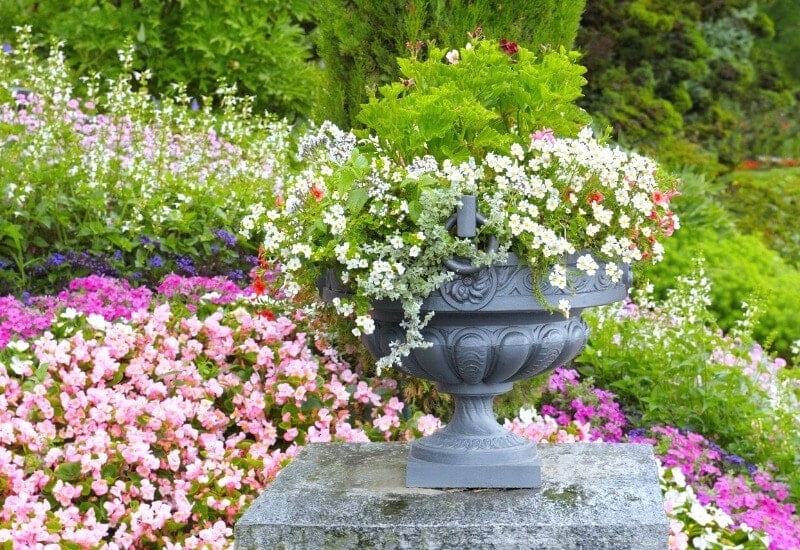
Now you know all the tried and tested methods for getting rid of grass and weed in your garden. On the whole, the best ones are the alternative organic ones. Most gardeners are realizing that chemicals in your soil will never lead to any good…
They are also safer and “more fun”, thinking about it. But first of all remember to assess your problem and choose a method that suits your needs. In particular, think about whether you want to prevent weeds or eradicate them…
Finally, remember to mulch after you have gone through the trouble of weeding your flower beds. This way, you will have a weed free garden for months or even years to come!

Written By
Adriano Bulla
After many years as an academic in London, Adriano Bulla became a writer, publishing books like A History of Gardening, Organic Gardening and Elements of Garden Design; he then decided to become a gardener, following his childhood dream, and has been following his dream writing and gardening professionally in Southern Europe, where he has specialized in new and innovative organic gardening fields and techniques, like permaculture, regenerative agriculture, food forests and hydroponics.

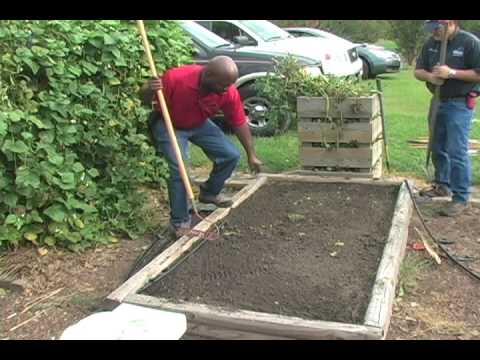
Good to know. Thanks for the good advice.
Do you have any plastic sheeting that is recyclable to recommend for solarization?